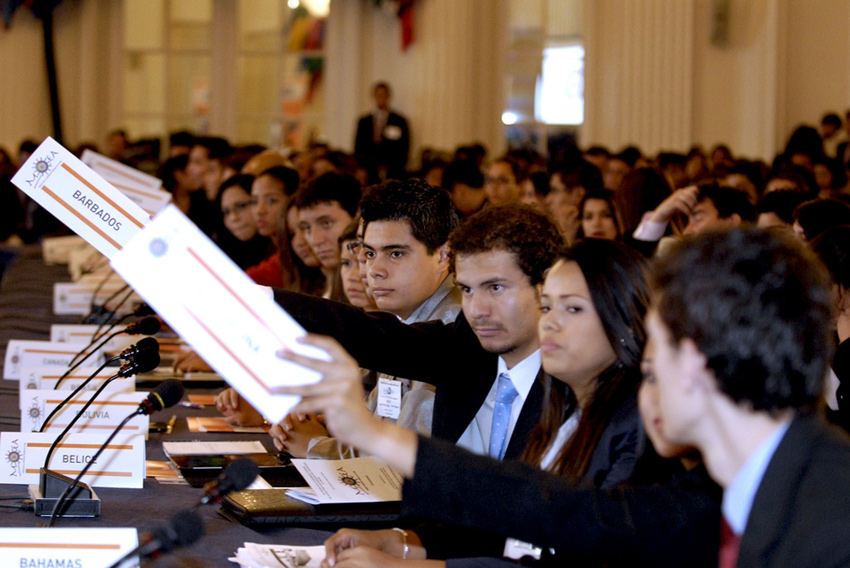- English
- Español
Media Center
Feature
Model OAS General Assemblies: from Students to Diplomats for a Few Days
October 7, 2015About 30,000 young people have participated in the Program since 1980.
The scene has repeated itself many times throughout the Americas. The halls of a university are busier and noisier than usual; in addition to the hectic atmosphere of exams, lectures and books, there are 400 young students coming from various corners of the country or the region, nervous as much as excited to become diplomats, at least for a few days. The event that brings them together: the Model OAS General Assembly (MOAS).
David Quiroz de Valledupar was one of these students in 2011, at the campus of the Universidad del Norte in Barranquilla, Colombia. In his role as Head of Delegation of Nicaragua, he had to deliver the keynote address to the Assembly. “My first day at the MOAS was simply fascinating,” David recalls. “The delegates were taking the floor and my turn was approaching; it was a combination of anxiety, fear, courage and desire to participate. What encouraged me most was knowing that I was seated at a table, like an Ambassador, and that I was with delegates that had extensive experience in the Models, so my challenge was to be as experienced and knowledgeable as they were.”
“The MOAS helped me to understand the importance of dialogue and teamwork, as well as the ability to tackle issues from a multidisciplinary standpoint. After this experience, I got involved in everything that’s related to public affairs and public policies.”
Andrés Delgado
Universidad Católica San Pablo, Arequipa, Peru (Chair, XXXII MOAS Arequipa, 2014)
The MOAS is an exercise in which high schools and university students, as well as OAS interns represent diplomats of the OAS member states in a mock General Assembly and discuss resolutions on current topics on the inter-American agenda. The program seeks to promote democratic values, tolerance, and consensus as participants learn about the work of the Organization and the priorities of the countries of the Hemisphere. Since its creation in 1980, this program has given about 30,000 young people of the Hemisphere the opportunity to practice their leadership, negotiation and diplomatic skills.
David still remembers the main message of his intervention during the MOAS, “the unity of the hemisphere,” and he is convinced that this idea “should not only remain in a model, but should be part of our daily lives as citizens of the Americas.” That was his first experience representing the Colegio de Santa Fe de Valledupar in the MOAS; his assurance, leadership, eloquence, and skill in communicating ideas and values captivated the audience of students, teachers and advisors that participated in the event. At 15 years old, he had a very clear objective: to become the Secretary General of the Model Assembly, and though he would play that role for only three days, it would allow him to “feel and be part of the solution of conflicts and issues facing our hemisphere.” Today, after three years of consecutive participation, his skills and leadership led him to obtain a scholarship to pursue a degree in economics in the same university that welcomed him three years ago.
More than an experience
Participation of students in the program is largely promoted by teachers and educational institutions’ authorities. Based on the feedback from participating teachers, gathered by the OAS program, the main lessons learned from the MOAS are:
- The value of cultural exchange with students from other schools and countries;
- Learning to reach consensus and common objectives within a heterogeneous community made up of large and small countries with different characteristics;
- The ability of young people to find innovative solutions to hemispheric challenges.
Various studies by the University of Oregon, the University of Kansas, and the Latin American Studies Association have shown that interactive learning methods and simulation exercises, such as the MOAS, are a teaching technique that increases the retention of the information presented, gives the student a better understanding of the information and their responsibility for their own training, and meets the needs and learning styles of students.
Javier Ergueta, Professor of History and Knowledge Theory and Faculty Advisor at the Wilmington Friends School in Delaware, United States and Faculty Advisor to the MOAS, explains that after participating in the program, students “return to school with the personal experience that their success in the Model depends on their knowledge of history, their analytical abilities and their communication skills. They return with a lot of enthusiasm to learn more about the world and to better perform in the classroom, because they want to be sure that they will participate in the next Model.”
Throughout the years, the MOAS Program has been developed and modernized to achieve high levels of participation and scope in various corners of the Hemisphere, from Saint Kitts and Nevis to Cochabamba, Bolivia. Annually, an average of 1,500 young people and 130 teachers learn the importance of diplomacy, negotiation and compromise in finding solutions to regional issues while developing leadership abilities. The next Model Assembly for High schools will take place at OAS headquarters from December 2-4, 2015, and will include participation from high schools from the United States, Colombia, Belize, Costa Rica, Ecuador, Mexico, and Peru.
“The MOAS exercise was a test of multiple dimensions. We witnessed testiness, challenges brought on by linguistic preferences, and the swapping of short tempers for stoicism as lunchtime loomed or sessions lengthened. But we have also seen and heard the laughter of nascent friendships and the bonds developed in after-work amity. We had a perfect opportunity to come close to an Organization that is ours, one which, faced with an imperfect world, imperfect systems, imperfect people, strives everyday to bring a brighter future to the Americas.”
Devon Yetman and Diana Hidalgo
Communication Center
MOAS for interns 2015
Reference: E-309/15



